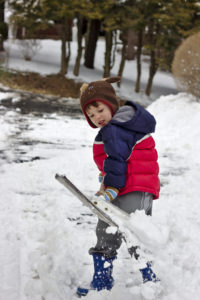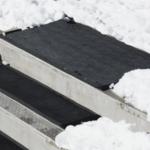How to Start Shoveling Snow Safely: A Closer Look at Each of These Snowfall Tips.

If you’ve spent even a few minutes behind a snow shovel, you know how exhausting and labor-intensive it can be. According to Harvard Medical School’s “Calories Burned…” chart, shoveling snow burns approximately 223 calories every 30 minutes (for a person weighing 155 lbs). That’s a serious workout! Unfortunately, many homeowners don’t realize that shoveling snow safely requires preparation and awareness since it’s such a vigorous form of exercise. We have tips to get you shoveling snow safely is crucial to avoid injury, as it can be a surprisingly strenuous activity if not approached with caution. Here are a few stats that may surprise you:
- Between 1990 and 2006, approximately 195,000 people in the United States were treated in a hospital emergency room as a result of shoveling injuries.
- According to a Harvard Health Publishing article written in 2017, the problem is still one we face today. Approximately 100 people (mainly men) die during or shortly after shoveling snow in the U.S. Even more are admitted to the hospital with complaints of chest pain.
These numbers are scary, to say the least.
To help prevent injuries To help prevent injuries and ensure you’re shoveling snow safely, we’ve compiled a list of the top 10 tips to ensure your safety while shoveling snow in your driveway.
- Assess Your Health Level
- Wear Proper Footwear
- Layer Your Clothing
- Stretch Before You Shovel Snow
- Choose An Ergonomically-Designed Shovel
- Lift With the Knees – Not the Back
- Know the Signs of a Heart Attack
- Take Frequent Breaks (& Call In Reinforcements if Possible)
- Shovel More Frequently For Lighter Snow Loads
- Stay Hydrated
Assess Your Health Level
Do you suffer from a heart condition? Do you have a weak back or neck? Has it been quite a long time since you’ve exercised? If so, you are more likely than others to experience an injury while using a shovel. You might be tempted to say, “Oh, I’m just fine. I can handle it.” But don’t do it.
Consider hiring a teenager in your area to remove your snow for you or ask a nearby relative. If this option is not available, consider alternate snow removal methods (stay tuned – we’ve got a fantastic one coming up at the end of this article!)
Wear Proper Footwear
While it’s not likely that you’re going to run outside in your summer flip-flops, you may be tempted to wear your most comfortable shoes while working to shovel snow. However, it’s most important to choose shoes that will keep your feet warm and dry. Otherwise, you run the risk of cold stress symptoms, including frostbite or Trench Foot (a painful condition caused by feet exposed to cold water for a long period of time, which can turn the feet black and kill surface tissue.)
In addition to choosing dry, warm shoes, it’s important to choose shoes with a marked tread. The last thing you want is to slip on a hidden piece of ice, which could easily result in an injury such as a bone fracture or concussion.
Layer Your Clothing
Have you ever bundled up to go out to the driveway, only to realize that you quickly worked up a sweat? Because snow shoveling is quite the unanticipated workout, it’s a great idea to layer your clothing. This protects you from getting too hot while shoveling, and you can shed layers as necessary.
Also, choose clothing that does not restrict body movement. It’s important to have full range of motion, so you can correctly remove the snow and avoid falling due to restricting clothing.
Stretch Before and After Shoveling
While it might feel weird to stretch before you shovel snow, it is actually really important. You’ll be using muscles that may not have been worked for a while. Stretching allows you to warm up your arms, legs, and back before the work begins to protect yourself from injury due to cold muscles. Stretching after exercise is also important to cool the muscles down.
Choose An Ergonomically-Designed Shovel
Ergonomic is a big word that simply means an object was created for the best, safest, most efficient use possible. Do your research to find a shovel that was designed with you in mind. Many shovels have curved handles, which are created to take the strain away from your back.
Others are designed with a second handle (often referred to as the “back-saving” handle) to allow for easier lifting motions.
There are even shovels on wheels that allow for pushing rather than lifting at all. Of course, these tend to come with a higher price tag as well. As far as pushing is concerned, if lifting is a problem, a snow blower is also an option to help ensure your safety while removing snow from your driveway.
Lift With the Knees – Not the Back
This is a tip you’ve likely heard before, whether you are shoveling snow or lifting a couch. When you bend your back while lifting, you’re likely trying to use it to bear the weight of the object. This is a surefire way to head to the ER with an unnecessary injury. Be real about the fact that snow is deceptively heavy. Always lift with the legs. Get those quads fired up!
Know the Signs of a Heart Attack
If you experience the following symptoms while shoveling, stop immediately and get to your nearest ER.
- Tightness, Pressure, or Pain In Your Chest or Arms
- Nausea and Abdominal Pain
- Cold Sweats
- Excessive Fatigue
- Sudden Dizziness
- Difficulty Breathing
These could be signs of a heart attack. Don’t take them lightly.
Take Frequent Breaks (& Call in Reinforcements If Possible)
Don’t try to “power through” when you’re feeling tired during snow shoveling. This will only increase the risk of injury to your arms, legs, back, neck, heart, and more. Listening to your body will allow you to protect yourself. Taking breaks is an important part of shoveling snow safely, as overexertion can lead to avoidable injuries. The extra time taken will be well worth it to avoid getting hurt. In addition, don’t try to hurry through the snow removal process (although it’s definitely tempting when there’s a lot of snow coming down.) Take your time.
If you’re finding the shovel duty to be particularly difficult on a given day, it’s best to call in reinforcements. Again, this could be hired help or a loved one. Don’t be afraid to ask for help.
Shovel More Frequently For Lighter Snow Loads
Have you ever tried to shovel a foot of snow on your driveway in one sitting? I know I have. But here’s the thing: It’s actually a lot better to come out and keep up with the snowfall than try and just clean it up after the storm hits. Think proactively rather than reactively. This will allow for lighter shovel loads, reduce strain on the heart and other areas of the body, and keep each shoveling session short – protecting you against prolonged exposure to the winter elements.
Stay Hydrated
As mentioned earlier, shoveling snow is hard physical labor! Have a water bottle handy and drink up. Avoid the possibility of getting dehydrated while on the job.
Powerblanket Ground-Thawing Blankets for Safer Snow Removal

Let’s be honest – some of us just do not want to shovel snow ever again. Or maybe you have a health condition that simply does not allow it. If that’s the case, there’s a better, easier snow removal option: Powerblanket Ground-Thawing Blankets.
These heavy-duty, heated ground-thawing blankets are designed to withstand tough winter conditions. While they were originally built for thawing frozen ground, they can also be used to melt snow and ice on driveways, walkways, and entryways.
Powerblanket ground-thawing blankets can melt up to 2 inches of snow per hour while in operation—offering fast, efficient snow removal without manual labor. This means you can do minimal to no shoveling and eliminate the normal roadblocks for shoveling snow safely.
These blankets eliminate time-consuming shoveling and reduce reliance on de-icing chemicals, all while helping prevent slips and falls that could cause serious injury.
Choose a Powerblanket Ground-Thawing Blanket for your home this winter – and enjoy a more relaxing, safe season indoors.
Have questions? Want to get started with your very own snow-melting mat? Give our Powerblanket experts a call today at 801.506.4203.
Frequently Asked Questions
What is the safest way to shovel snow?
The safest way to shovel snow is to lift with your legs instead of your back, wear layered clothing, stay hydrated, and take frequent breaks to avoid exhaustion.
At what age should a man stop shoveling snow?
Men over the age of 40 or those with a history of heart disease should consult a doctor before shoveling snow, as it can pose significant health risks.
What not to do after shoveling snow?
Avoid eating a heavy meal or consuming alcoholic beverages immediately before or after shoveling, as these can increase the strain on your heart.
What is the most common injury in shoveling?
The most common injuries from shoveling snow include sprains and strains, particularly in the back and shoulders, as well as lacerations.
Keep your steps, doorways and walkways safe this winter with our ground-thawing and snow-melting blankets.




